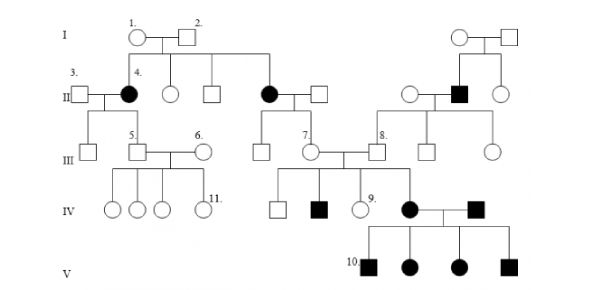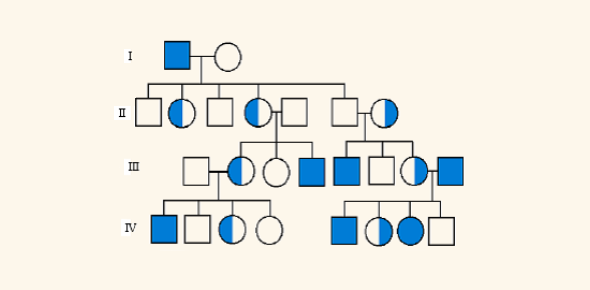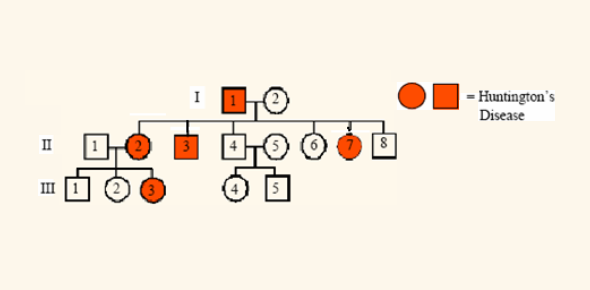Pedigree Analysis Quiz Questions With Answers
(134).jpg)
Ready to dive into the world of pedigree analysis? Our Pedigree Analysis Quiz Questions with Answers is here to make learning about inheritance patterns and genetics a breeze! Explore a variety of fun and informative questions that cover everything from dominant and recessive traits to genetic disorders. Plus, with answers provided, you can check your understanding as you go and learn along the way. Whether you're studying for a biology exam or just curious about your family's genetic history, this quiz is perfect for you!
Participants of this quiz can expect to encounter a wide range of questions covering various aspects Read moreof pedigree analysis. From identifying patterns of inheritance, such as autosomal dominant, autosomal recessive, and X-linked inheritance, to interpreting pedigree charts to determine the likelihood of passing on genetic traits, this quiz covers it all. So, take the test now!
Pedigree Analysis Questions and Answers
- 1.
In the above pedigree, the affected individuals are shown shaded. None of the marriage partners from outside these two families are heterozygous for the trait. What is the inheritance pattern for this trait?
- A.
Codominant Inheritance:
- B.
Autosomal recessive
- C.
Sex linked dominant
- D.
X-Linked Dominant Inheritance:
- E.
Option 5
Correct Answer
B. Autosomal recessiveExplanation
Recessive because if skips generations I and III; Autosomal because equal number of males and females affected (5 to 5)Rate this question:
-
- 2.
In the above pedigree, the affected individuals are shown shaded. None of the marriage partners from outside these two families are heterozygous for the trait. Indicate the genotype(s) of individual # 1 (Allow the dominant trait to be “A” and the recessive trait to be “a” – NOTE: Some may have two possible genotypes)
- A.
AA
- B.
Aa
- C.
Aa
Correct Answer
B. AaExplanation
Based on the information provided, the affected individuals in the pedigree are shown shaded. Since none of the marriage partners from outside these two families are heterozygous for the trait, it can be inferred that the trait is likely inherited in an autosomal recessive manner. Individual #1 is not affected, so they could either be homozygous dominant (AA) or heterozygous (Aa) for the trait. Since the trait is not shown in either of their parents, it is more likely that individual #1 is heterozygous (Aa) for the trait.Rate this question:
-
- 3.
In the above pedigree, the affected individuals are shown shaded. None of the marriage partners from outside these two families are heterozygous for the trait. Indicate the genotype(s) of individual # 2 (Allow the dominant trait to be “A” and the recessive trait to be “a” – NOTE: Some may have two possible genotypes)
- A.
AA
- B.
Aa
- C.
Aa
Correct Answer
B. AaExplanation
Individual #2 can have a genotype of Aa because they are affected by the trait, which means they must have at least one copy of the dominant allele A. However, since they are affected, they must also have a copy of the recessive allele a. Therefore, their genotype can be Aa.Rate this question:
-
- 4.
In the above pedigree, the affected individuals are shown shaded. None of the marriage partners from outside these two families are heterozygous for the trait. Indicate the genotype(s) of individual # 3 (Allow the dominant trait to be “A” and the recessive trait to be “a” – NOTE: Some may have two possible genotypes)
- A.
AA
- B.
Aa
- C.
Aa
Correct Answer
A. AAExplanation
Individual #3 must have the genotype AA because the trait is dominant and both of their parents are affected (shaded), meaning they have at least one copy of the dominant allele. Since none of the marriage partners from outside the families are heterozygous for the trait, it can be inferred that both parents of individual #3 are homozygous dominant (AA).Rate this question:
-
- 5.
In a pedigree chart, if two unaffected individuals have a child with the trait, what is the most likely mode of inheritance for this trait?
- A.
Autosomal dominant
- B.
Autosomal recessive
- C.
X-linked dominant
- D.
X-linked recessive
Correct Answer
B. Autosomal recessiveExplanation
If two unaffected individuals (neither of them has the trait) have a child with the trait, the most likely mode of inheritance for this trait is autosomal recessive.
In autosomal recessive inheritance, the trait is typically "hidden" or not expressed in carriers (heterozygous individuals), but it can be expressed when two carriers have a child together, and both pass on the recessive allele for the trait. This means that two unaffected parents can have a child with the trait if they both carry a single copy of the recessive allele and pass it on to their child. This scenario is characteristic of autosomal recessive inheritance.Rate this question:
-
- 6.
In the above pedigree, the affected individuals are shown shaded. None of the marriage partners from outside these two families are heterozygous for the trait. Indicate the genotype(s) of individual # 5 (Allow the dominant trait to be “A” and the recessive trait to be “a” – NOTE: Some may have two possible genotypes)
- A.
AA
- B.
Aa
- C.
Aa
Correct Answer
B. Aa -
- 7.
In the above pedigree, the affected individuals are shown shaded. None of the marriage partners from outside these two families are heterozygous for the trait. Indicate the genotype(s) of individual # 6 (Allow the dominant trait to be “A” and the recessive trait to be “a” – NOTE: Some may have two possible genotypes)
- A.
AA
- B.
Aa
- C.
Aa
Correct Answer
C. AaExplanation
Individual #6 must have the genotype aa because the trait is dominant and both of their parents are affected, meaning they must carry at least one copy of the dominant allele. Since the trait is not present in any of the marriage partners from outside the two families, it can be concluded that the trait is not inherited from any outside source and must be inherited from the affected parents.Rate this question:
-
- 8.
In the above pedigree, the affected individuals are shown shaded. None of the marriage partners from outside these two families are heterozygous for the trait. Indicate the genotype(s) of individual # 7 (Allow the dominant trait to be “A” and the recessive trait to be “a” – NOTE: Some may have two possible genotypes)
- A.
AA
- B.
Aa
- C.
Aa
Correct Answer
B. AaExplanation
Individual #7 can have the genotype Aa. This is because the affected individuals in the pedigree are shown as shaded, indicating that they have the dominant trait. Since individual #7 is affected, they must have at least one copy of the dominant allele, which is represented by "A". However, since none of the marriage partners from outside these two families are heterozygous for the trait, individual #7 cannot have the genotype AA. Therefore, the only possible genotype for individual #7 is Aa.Rate this question:
-
- 9.
In the above pedigree, the affected individuals are shown shaded. None of the marriage partners from outside these two families are heterozygous for the trait. Indicate the genotype(s) of individual # 8 (Allow the dominant trait to be “A” and the recessive trait to be “a” – NOTE: Some may have two possible genotypes)
- A.
AA
- B.
Aa
- C.
Aa
Correct Answer
B. AaExplanation
Individual #8 can have the genotype Aa. This is because the trait is dominant, and individual #8 is affected, which means they must have at least one dominant allele. Since none of the marriage partners from outside the families are heterozygous for the trait, it is likely that individual #8 inherited the dominant allele from one of their parents who is affected. Therefore, individual #8 can have the genotype Aa.Rate this question:
-
- 10.
In the above pedigree, the affected individuals are shown shaded. None of the marriage partners from outside these two families are heterozygous for the trait. Indicate the genotype(s) of individual # 9 (Allow the dominant trait to be “A” and the recessive trait to be “a” – NOTE: Some may have two possible genotypes)
- A.
AA
- B.
Aa
- C.
Aa
Correct Answer(s)
A. AA
B. AaExplanation
Based on the information given, we can determine that the trait being referred to is dominant. Since none of the marriage partners from outside these two families are heterozygous for the trait, it implies that both parents of individual #9 are affected. Therefore, individual #9 can have either the genotype AA or Aa.Rate this question:
-
- 11.
In the above pedigree, the affected individuals are shown shaded. None of the marriage partners from outside these two families are heterozygous for the trait. Indicate the genotype(s) of individual # 10 (Allow the dominant trait to be “A” and the recessive trait to be “a” – NOTE: Some may have two possible genotypes)
- A.
AA
- B.
Aa
- C.
Aa
Correct Answer
C. AaExplanation
Based on the information provided, we know that the trait is recessive since none of the marriage partners from outside these two families are heterozygous for the trait. Individual #10 is affected, which means they must have two copies of the recessive allele. Therefore, the genotype of individual #10 can only be aa.Rate this question:
-
- 12.
In the above pedigree, the affected individuals are shown shaded. None of the marriage partners from outside these two families are heterozygous for the trait. Indicate the genotype(s) of individual # 11 (Allow the dominant trait to be “A” and the recessive trait to be “a” – NOTE: Some may have two possible genotypes)
- A.
AA
- B.
Aa
- C.
Aa
Correct Answer(s)
A. AA
C. AaExplanation
Individual #11 is the child of two affected individuals, who are both shaded in the pedigree. Since the trait is shown as shaded, it is likely a dominant trait. Both affected individuals could either be heterozygous (Aa) or homozygous dominant (AA). Therefore, individual #11 could have either the genotype aa or AA.Rate this question:
-
- 13.
What pattern of inheritance does this pedigree demonstrate?
- A.
Autosomal
- B.
Sex linked
Correct Answer
B. Sex linkedExplanation
More males affected than femalesRate this question:
-
- 14.
What pattern of inheritance does this pedigree demonstrate? (HINT: Look carefully... practice with genotypes if necessary)
- A.
Dominant
- B.
Recessive
Correct Answer
B. RecessiveExplanation
#4 XBXb female and must be heterozygous as one of her sons has trait because dad (#3) must be XbY BUT passed a Y to his SON...Rate this question:
-
- 15.
Indicate the pattern of inheritance observed for pedigree A.
- A.
Dominant
- B.
Recessive
Correct Answer
B. RecessiveExplanation
Recessive because skips a generation: COULD BE Autosomal Recessive bc Neither parent has the trait but one offspring expressed it COULD BE X-linked Recessive bc Neither parent has it but one SON expressed itRate this question:
-
- 16.
Indicate the pattern of inheritance observed for pedigree B.
- A.
Autosomal dominant
- B.
Autosomal recessive
- C.
Sex linked dominant
- D.
Sex linked recessive
Correct Answer
C. Sex linked dominantExplanation
Both of the daughters express the trait, neither SON does, both parents have itRate this question:
-
- 17.
Indicate the pattern of inheritance observed for pedigree C.
- A.
Autosomal dominant
- B.
Autosomal recessive
- C.
Sex linked dominant
- D.
Sex linked recessive
Correct Answer
B. Autosomal recessiveExplanation
Neither parent expresses the trait but one son and one daughter express the traitRate this question:
-
- 18.
Indicate the pattern of inheritance observed for pedigree D.
- A.
Dominant
- B.
Recessive
Correct Answer
A. DominantExplanation
dominant because in every generation: COULD BE X-linked dominant bc Both daughters express the trait, inherited from the fathers affected X chromosome, neither son expresses the trait - COULD BE Autosomal Dominant bc Only the daughters inherited the faulty chromosome from the father by chanceRate this question:
-
- 19.
Indicate the pattern of inheritance observed for pedigree E.
- A.
Autosomal
- B.
X-Linked
- C.
Y-Linked
Correct Answer
C. Y-LinkedExplanation
Only the males in the family are affected by the disorder AND NO daughters are affected... Just proving there are Y linked traits... This was a CHALLENGE Question :)Rate this question:
-
- 20.
What pattern of inheritance is shown in the pedigree?
- A.
Autosomal dominant
- B.
Autosomal recessive
- C.
Sex linked dominant
- D.
Sex linked recessive
Correct Answer
B. Autosomal recessiveExplanation
Autosomal recessive inheritance is a pattern of inheritance where a single copy of a mutated gene, located on one of the autosomes (non-sex chromosomes), is sufficient to cause the expression of a trait or disorder. In other words, the presence of one mutant allele is enough to result in the trait, even if the other allele is normal.Rate this question:
-
- 21.
What pattern of inheritance is shown in the pedigree?
- A.
Autosomal dominant
- B.
Autosomal recessive
- C.
Sex linked dominant
- D.
Sex linked recessive
Correct Answer
B. Autosomal recessiveExplanation
Skips generation I on one side of the family and skips generation III - equal numbers affectedRate this question:
-
- 22.
What pattern of inheritance is shown in the pedigree?
- A.
Autosomal dominant
- B.
Autosomal recessive
- C.
Sex linked dominant
- D.
Sex linked recessive
Correct Answer
D. Sex linked recessiveExplanation
recessive because carriers - sex linked because only females are carriers and more males affected than femalesRate this question:
-
- 23.
What pattern of inheritance is shown in the pedigree?
- A.
Autosomal dominant
- B.
Autosomal recessive
- C.
Sex linked dominant
- D.
Sex linked recessive
Correct Answer
A. Autosomal dominantExplanation
dominant because no carriers and occurs in every genration - autosomal because nearly equal males and females affectedRate this question:
-
- 24.
What pattern of inheritance is shown in the pedigree?
- A.
Autosomal dominant
- B.
Autosomal recessive
- C.
Sex linked dominant
- D.
Sex linked recessive
Correct Answer
B. Autosomal recessiveExplanation
recessive because skips generations I and III AND males and females are HETEROZYGOUS (Carriers) - autosomal because males can be heterozygous carriersRate this question:
-
Quiz Review Timeline +
Our quizzes are rigorously reviewed, monitored and continuously updated by our expert board to maintain accuracy, relevance, and timeliness.
-
Current Version
-
Apr 10, 2024Quiz Edited by
ProProfs Editorial Team -
Feb 06, 2016Quiz Created by
J Cook
- Anatomy Quizzes
- Bacteria Quizzes
- Bio Quizzes
- Biological Evolution Quizzes
- Biology Exam Quizzes
- Biology Test Quizzes
- Cell Quizzes
- Cell Biology Quizzes
- Chapters Of Biology Quizzes
- Classical Conditioning Quizzes
- Conservation Biology Quizzes
- Enzyme Quizzes
- Fungi Quizzes
- General Biology Quizzes
- Immunology Quizzes
- Macromolecule Quizzes
- Marine Biology Quizzes
- Microbiology Quizzes
- Mitosis And Meiosis Quizzes
- Molecular Biology Quizzes
- Parasitology Quizzes
- Physiology Quizzes
- Prokaryote Quizzes
- Protist And Fungi Quizzes
- Protozoa Quizzes
- Respiratory Quizzes
- Spine Quizzes
- Stem Cell Quizzes
- Taxonomy Quizzes
- Traits Quizzes
- Ultimate Biology Quizzes
- Virus Quizzes
- Zoology Quizzes
 Back to top
Back to top




.webp)
.webp)
.webp)
.webp)
(1).webp)
(2).webp)
(3).webp)
(4).webp)
(5).webp)
(6).webp)

.webp)

.webp)
.webp)
.webp)
.webp)
.webp)
.webp)


.webp)